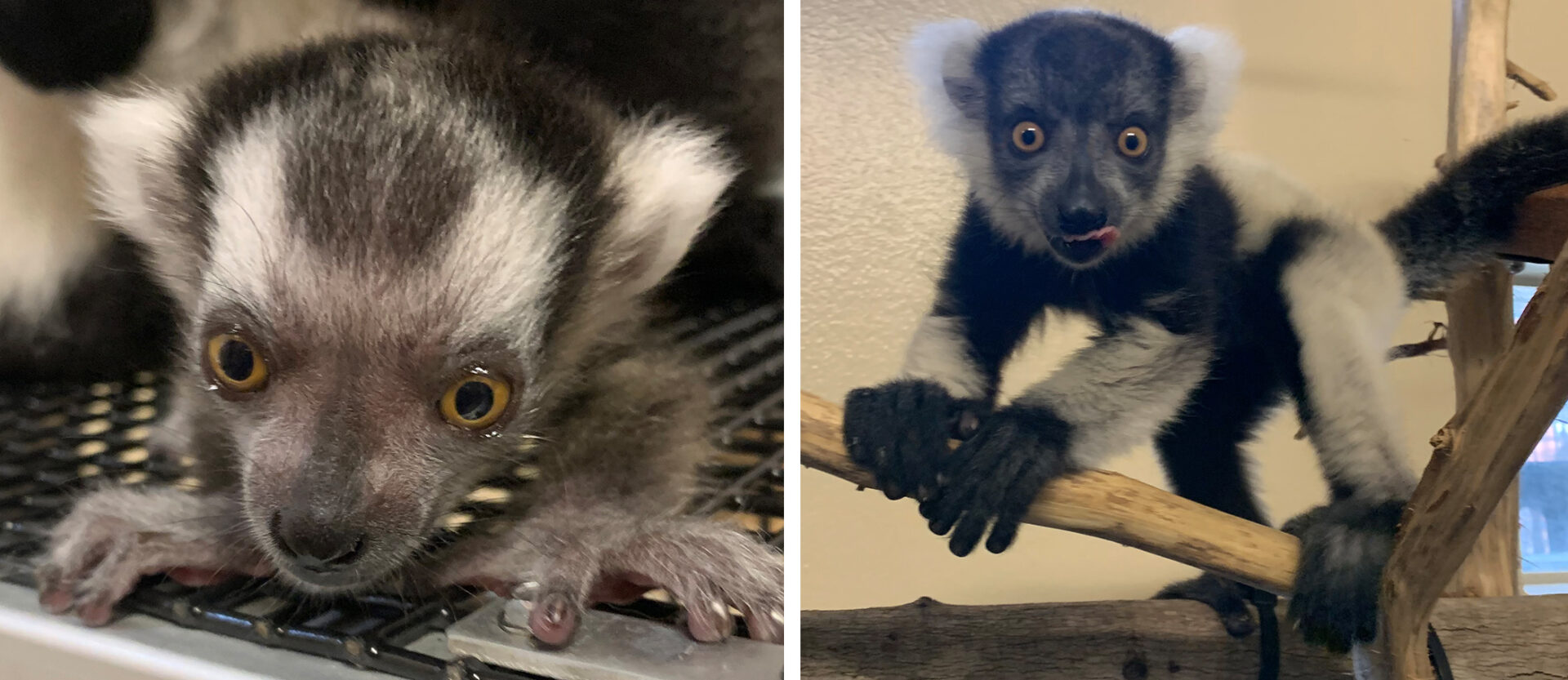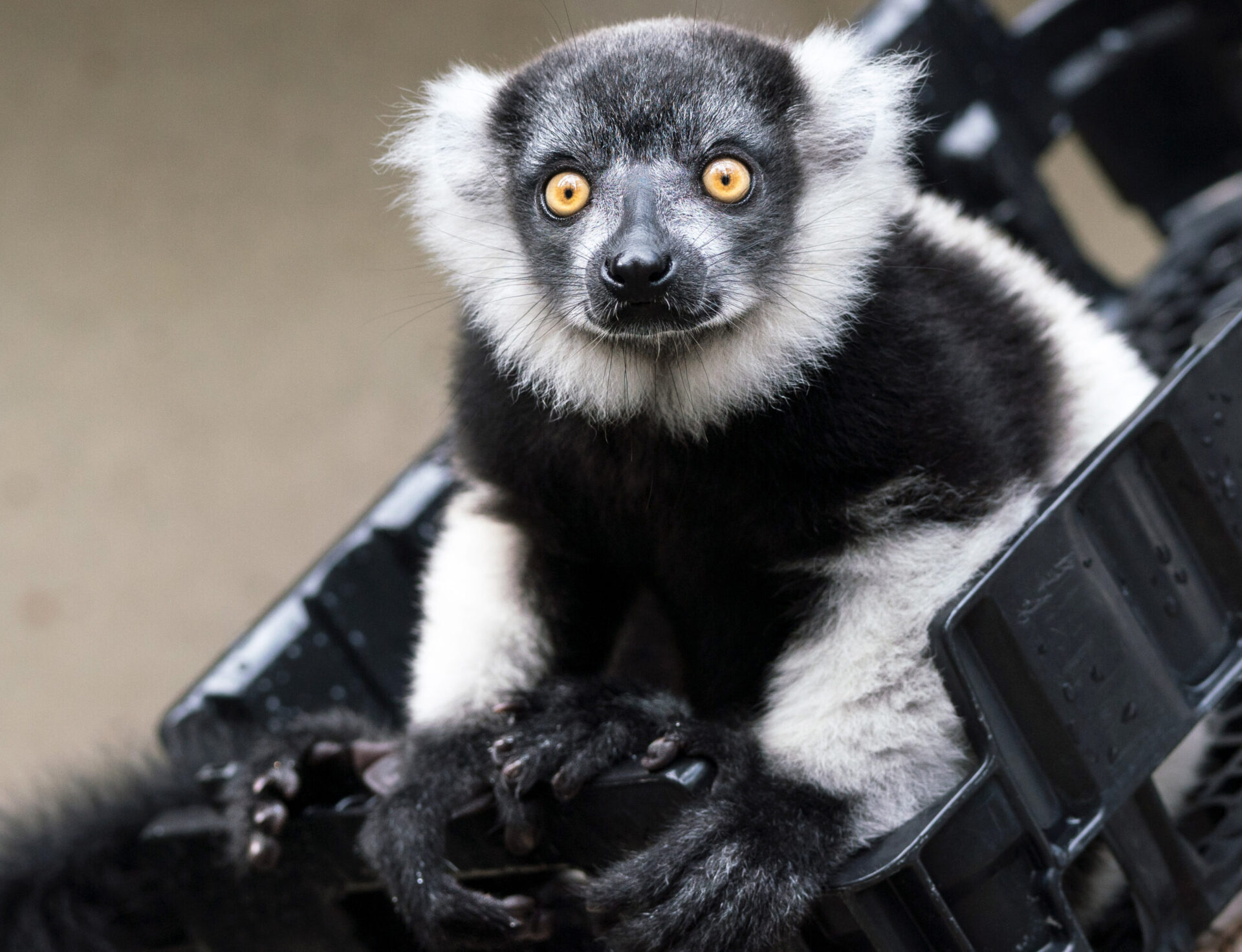
Ripley, a critically endangered black and white ruffed lemur (Varecia variegata), was born to first-time parents Herschel and Hermione on May 12, 2020. Welcome to the DLC family, Ripley! Photo by Sara Clark.
Meet Ripley, a critically endangered black and white ruffed lemur (Varecia variegata) born to first-time parents Herschel and Hermione! Ripley was born May 12, 2020 and is named after a crater on Pluto’s moon—which was named after Sigourney Weaver’s character in Alien!
Our Ripley is brave, bold, and adventurous, just like her fictional namesake. At feeding time, she’s not afraid to push her parents away and let them know she needs more space to eat! She is a great climber and seems to enjoy hanging upside down from the top of her outdoor enclosure.
Whereas most lemurs give birth to one or two babies at a time, ruffed lemurs are capable of having up to six infants in one litter! We’re sure Hermione is grateful for just one baby to ease her into motherhood.
Due to the size of their litters, ruffed lemurs are the only diurnal primates in the world to keep their infants in a nest, where mothers “park” their infants while they go off to forage. At birth, ruffed lemur infants aren’t capable of grasping onto their mother, so if she needs to transport them, she must pick them up and move them one at a time in her mouth. That is, until the infant is big and strong enough to follow mom on her own, which for Ripley seemed to happen overnight!

As a very young infant, Ripley had striking and unusual white markings on her forehead. Although still visible, the white has faded as Ripley has grown. Photos by one of Ripley’s primary caretakers, Matt Cuskelly.
Join us for BABY WEEK 2020!
The Duke Lemur Center has welcomed numerous infants this summer through our conservation breeding program, and we’re announcing six — yes, SIX! — of the newest babies this week! Here’s how to make sure you don’t miss ANY of these special announcements, or the accompanying photos and videos:
Follow us on Facebook: Visit our Facebook page, click “Follow,” and select “See First” from the dropdown menu
Like us on Instagram: Search for @dukelemurcenter
Meet our other BABY WEEK infants:
Myna, a fat-tailed dwarf lemur (announced Monday, July 20)
Siwa, an endangered crowned lemur (announced Wednesday, July 22)

Ripley settles into a basket and contemplates the camera. Photo by Sara Clark.
Learn more
Learn all about ruffed lemurs on our Meet the Lemurs page!
In 1997, the Duke Lemur Center, as part of a consortium of zoos and conservation groups known as the MFG (Madagascar Fauna & Flora Group), released five black and white ruffed lemurs into the Betampona Reserve in eastern Madagascar to restock the natural population there. The introduced lemurs had been born, and had lived their entire lives, in the forested Natural Habitat Enclosures of the DLC.
In 1998 and 2001, two more groups of U.S.-born lemurs were released into the Reserve. All of these lemurs had attended “lemur boot camp” free-ranging in forested enclosures at the DLC, and the more such experience they had, the more adept they seemed to be at facing the challenges presented by the wilds of Madagascar. Of the 12 animals released, as many as six successfully bred in the wild, most likely providing a much needed infusion of fresh genetic material into the wild population.
British comedian and avid lemur supporter John Cleese produced a documentary titled *Into the Wild* about the American-born ruffed lemurs’ release into Betampona Reserve, and funds from the U.K. premiere of *Fierce Creatures*, a follow-up film to Cleese’s *A Fish Called Wanda*, provided critical support for the reintroduction project.
What to learn more about the reintroduction? See “Into the Wild: Surviving pioneer lemurs celebrate a decade in the rain forest,” by Karl Bates, or visit the MFG webpage dedicated to the project.
How you can help ruffed lemurs
Adopt Halley, a black and white ruffed lemur: If you want to learn more about ruffed lemurs AND help support their care and conservation, please consider symbolically adopting Halley through the DLC’s Adopt a Lemur Program! Your adoption goes toward the $8,400 per year cost it takes to care for each lemur at the DLC, as well as aiding our conservation efforts in Madagascar. You’ll also receive quarterly updates and photos, making this a fun, educational gift that keeps giving all year long! Adoption packages start at just $50. Please visit our Adopt a Lemur homepage to learn more.
Send a “baby shower” gift: Make a ruffed lemur’s day by sending a special gift in Ripley’s honor via the DLC’s amazon.com wishlist!
Contribute to baby Ripley’s “scholarship fund”: Did you know it costs $8,400 per year to care for one lemur at the DLC — including baby Ripley? We rely upon donations from individuals like you, who personally invest in our work to care for lemurs and protect their habitat in Madagascar. To learn more about the DLC’s “return on investment,” please see our 2019 stewardship booklet. A heartfelt THANK YOU for your support — we couldn’t do this work without you!

